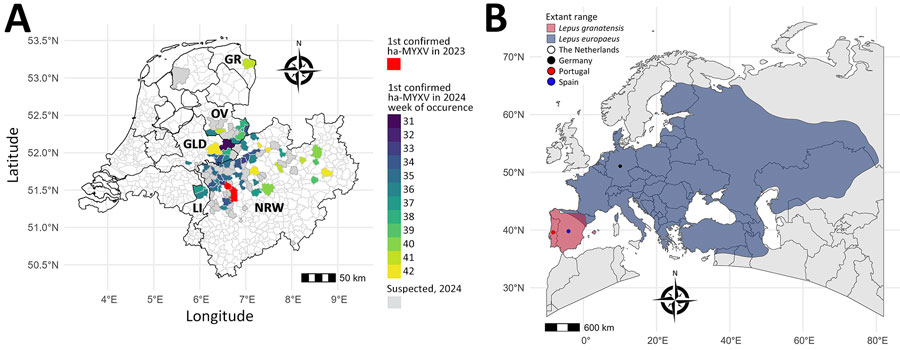Recombinant Myxoma Virus in European Brown Hares, 2023–2024
Luisa Fischer

, Erwin de Bruin, Evelien Jongepier, Erik Koffeman, Patricia König, Florian Pfaff, Martin Peters, Judith M.A. van den Brand, Marin Bussi, Dominik Fischer, Valentina Caliendo, Erik Weerts, Jooske IJzer, Janina Müller, Ann-Katrin Kühling, Maren Kummerfeld, Jana Müller, Henning Petersen, Sabine Merbach, Martin Beer, Mathilde Uiterwijk, Karst de Boer, and Jolianne M. Rijks
Author affiliation: Research Center for Hunting Science and Wildlife Management, State Agency for Consumer Protection and Nutrition North Rhine-Westphalia, Bonn, Germany (L. Fischer); Dutch Wildlife Health Centre, Utrecht University, Utrecht, the Netherlands (E. de Bruin, J.M.A. van den Brand, M. Bussi, V. Caliendo, E. Weerts, J. IJzer, J.M. Rijks); Royal Dutch Hunters’ Association, Amersfoort, the Netherlands (E. Jongepier); Fauna Management Unit Gelderland, Arnhem, the Netherlands (E. Koffeman); Friedrich-Loeffler-Institut, Greifswald-Insel Riems, Germany (P. König, F. Pfaff, M. Beer); Chemical and Veterinary Investigation Office Westphalia, Arnsberg, Germany (M. Peters, S. Merbach); Der Grüne Zoo Wuppertal, Wuppertal, Germany (D. Fischer); Chemical and Veterinary Investigation Office Rhein-Ruhr-Wupper, Krefeld, Germany (Janina Müller, A.-K. Kühling); Chemical and Veterinary Investigation Office Münsterland-Emscher-Lippe, Münster, Germany (M. Kummerfeld); Chemical and Veterinary Investigation Office Ostwestfalen-Lippe, Detmold, Germany (Jana Müller, H. Petersen); Centre for Monitoring of Vectors, Netherlands Food and Consumer Product Safety Authority, Wageningen, the Netherlands (M. Uiterwijk, K. de Boer)
Main Article
Figure 1

Figure 1. Location of an outbreak of ha-MYXV during 2024 in European brown hares (Lepus europaeus) in the border area of the Netherlands and Germany compared with ranges of the hares and the Iberian hare (Lepus granatensis). A) Municipalities and provinces in the Netherlands and the Germany federal state of North-Rhine Westphalia, showing the presumed epicenter of the outbreak (municipalities in which ha-MYXV occurred in 2023), as well as the spatiotemporal development of the outbreak in European brown hares during August 1–October 20, 2024. Confirmed ha-MYXV cases occurred in the Netherlands provinces Limburg, Gelderland, Overijssel, and Groningen and in North-Rhine Westphalia. Municipalities without laboratory-confirmed ha-MYXV cases during the study period, but where ha-MYXV-infection in hares was suspected on the basis of pathology, electron microscopy, or photographs of affected hares provide an indication of the probable area of virus presence, are indicated. Map created in R version 4.4.1 (The R Project for Statistical Computing, https://www.r-project.org). B) Extant ranges of both hare species. The outbreak area in northwest Europe is in the western part of the extant range of the European brown hare and far from the extant range of the Iberian hare, in which ha-MYXV was discovered in 2018, causing disease in both Spain and Portugal. Source of extant range shapes: International Union for Conservation of Nature. ha-MYXV, hare-adapted natural recombinant myxoma virus.
Main Article
Page created: July 02, 2025
Page updated: July 22, 2025
Page reviewed: July 22, 2025
The conclusions, findings, and opinions expressed by authors contributing to this journal do not necessarily reflect the official position of the U.S. Department of Health and Human Services, the Public Health Service, the Centers for Disease Control and Prevention, or the authors' affiliated institutions. Use of trade names is for identification only and does not imply endorsement by any of the groups named above.
